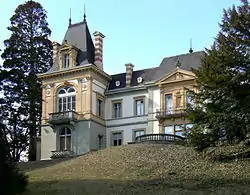James-Ferdinand de Pury
Baron James-Ferdinand de Pury (1823 – 15 May 1902) was a Swiss businessman and philanthropist. He amassed a large fortune through his business in the Brazilian tobacco trade, and was knighted by Pedro II of Brazil. His villa in Neuchâtel now houses the Musée d'ethnographie de Neuchâtel.
James-Ferdinand de Pury | |
|---|---|
| Born | 1823 Neuchâtel, Switzerland |
| Died | 15 May 1902 Neuchâtel, Switzerland |
| Occupation | businessman, philanthropist |
| Spouse(s) | Augustine-Marie Bevilaqua |
| Children | 1 |
| Parent(s) | Baron Charles Auguste de Pury Countess Sophie Marianne de Pourtalès |
Biography
De Pury was born in 1823 in Neuchâtel, the fourth child of Baron Charles Auguste de Pury, the mayor of La Côte, and Countess Sophie Marianne de Pourtalès, a member of a French-Swiss noble family.[1] His great-grandfather, Abraham Bernard, was a childhood friend and relative of Jean-Jacques Rousseau.[2] While a relative of the philanthropist David de Pury, he was not a descendant of the same family line.[2]
In 1846, when he was twenty-three years old, de Pury moved to Bahia, Brazil to work for a tobacco company owned by his uncle, Auguste de Meuron.[1][2] He was successful in the tobacco business and amassed a fortune.[1] He was made a knight of the Order of the Rose by Pedro II of Brazil for his contributions to the tobacco trade.[2]

In 1863 he married Augustine-Marie Bevilaqua, a Brazilian woman who was twenty years his junior.[1][2] They had one daughter, Mathilde, who was born in 1868.[1] The family later moved back to Switzerland. In 1872, de Pury had a grand villa built on the Hill of St-Nicolas in Neuchâtel, designed by the architect Léo Châtelain.[1][2][3] He retired from business in 1879, dedicating his time to philanthropic causes and hosting society functions.[2] De Pury provided the local art museum with several paintings for their collection and left a carved ivory piece made by the Vili people to the ethnography museum.[2][4]

De Pury's daughter died in 1882 and his wife died in 1900.[2] He died on 15 May 1902.[2] Left without an heir, he bequeathed his villa to the city of Neuchâtel so that it could be made into a museum.[2][4][5] The house, known as the Villa James de Pury, now houses the Musée d'ethnographie de Neuchâtel.[1][4] The entrance of the museum contains a plaque commemorating de Pury.[2]
References
- "Musée d'Ethnographie de Neuchâtel: de Pury James-Ferdinand". www.men.ch. Archived from the original on November 30, 2017. Retrieved January 1, 2021.
- "Musée d'Ethnographie de Neuchâtel: James-Ferdinand de Pury détail". www.men.ch. Retrieved January 2, 2021.
- Gloor, Lea (May 7, 2016). "Neuchâtel: provisional grant for the restoration of the Villa de Pury". Arcinfo. Archived from the original on July 6, 2016.
- "Ethnography Museum of Neuchâtel, Switzerland". HiSoUR. February 1, 2020. Archived from the original on February 15, 2020.
- "Musee d'Ethnographie Neuchatel, Switzerland". Museum Travelers. February 26, 2018. Archived from the original on March 11, 2019.